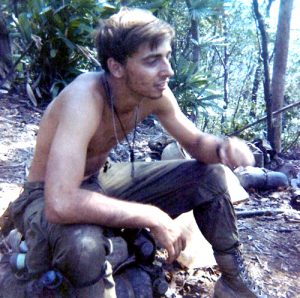Veterans of one of the fiercest battles in the Vietnam War to gather and tell their untold story in free event at Relic Room
March 12, 2020Specialist Frank Marshall and his comrades in the 2nd of the 506th, 101st Airborne Division, fought the very last major battle Americans experienced during the Vietnam War.
It’s regarded as one of the bloodiest fights of the war. They lost 139 men, and hundreds of others were wounded. And no one back home even knew about it.
“When we first got home, nobody would believe us, nobody wanted to hear,” he remembers now. “We were in one of the worst battles of the war, and nobody even knows about it.”
The folks back home will know more on Saturday, March 28. That’s when the South Carolina Confederate Relic Room and Military Museum will unveil its new diorama of Fire Support Base Ripcord, designed and constructed by the Wildcat Chapter, Armor Modeling and Preservation Society. The meticulously detailed diorama, which shows the entire base and hill it was on, will be the first piece of the museum’s major Vietnam exhibit that will open fully in the fall.
The event, which will run from 10 a.m. to 4 p.m. at the museum at 301 Gervais Street, is free and open to the public.
Frank and other veterans of the Battle of Fire Support Base Ripcord will speak about their experience at 11 a.m. At 2 p.m., the builders of the diorama will tell how they did it – a painstaking task that took two years. Then at 3:30, former Lt. James Lawrence, a Citadel graduate and veteran of the U.S. Army’s first big battle in the war – the one featured in the film “We Were Soldiers” – will talk about his role in that battle, and also speak to the significance of what happened at Ripcord.
Ripcord was located several miles south of “Hamburger Hill” in the A Shau valley, where soldiers of the same division had sustained heavy losses in May 1969. That battle was the subject of a Hollywood movie, unlike the one a year later.
Fierce fighting against the North Vietnamese Army occurred in and around Ripcord between March 12 and July 23, 1970. Three Medals of Honor and six Distinguished Service Crosses were awarded to participants for actions during the final 23 days in July, when the combat was continuous.
For Frank and the other guys in A Company, it started when they flew in on helicopters on March 12. “The NVA were just hitting us with everything.” His lieutenant, and a couple of other guys in the company, were killed. It would take the battalion until April 15 to establish the base, getting the artillery in place.
While Bravo company dug in on the base’s perimeter, Frank’s unit patrolled farther out. Their mission was to protect the artillery, which was there to support a planned offensive by the 101st to destroy NVA supply bases in the area. The only way in or out was by helicopter.
The troops protecting the base experienced periodic firefights until July 2. From then on, the fighting went on without letup. And they got little support. The U.S. government was cutting back on the U.S. ground combat role – President Nixon had started withdrawing troops the previous year – and there just wasn’t enough help available.
“We fought ’em all day” on July 22, Frank says. “At the end of the day, the only thing that saved our lives was we called in a danger-close airstrike.” Alpha had 14 dead, and 56 wounded. Frank himself had been hit three times. The third time happened while a medic was treating his second wound. Then, the F-4 Phantom dropped its 250-pound bomb on the U.S. position. That, finally, drove off the enemy long enough for the Americans to evacuate.
Frank spent six weeks at the Air Force hospital at Cam Ranh Bay. He was returned to his unit with a couple of weeks left in his tour. Fortunately, “They kept me in the rear” after that.
For Frank, getting together with a dozen or so of his comrades on March 28 will be something special. “I wouldn’t be here today if not for these guys,” he says, and it’s the first time they’ll be back together in 50 years.
“We’re all looking forward to it.”
About the South Carolina Confederate Relic Room and Military Museum
Founded in 1896, the South Carolina Confederate Relic Room and Military Museum is an accredited museum focusing on South Carolina’s distinguished martial tradition through the Revolutionary War, Mexican War, Civil War, Spanish-American War, World Wars I and II, Vietnam, the War on Terror, and other American conflicts. It serves as the state’s military history museum by collecting, preserving, and exhibiting South Carolina’s military heritage from the colonial era to the present, and by providing superior educational experiences and programming. It is located at 301 Gervais St. in Columbia, sharing the Columbia Mills building with the State Museum. For more information, go to https://crr.sc.gov/.














